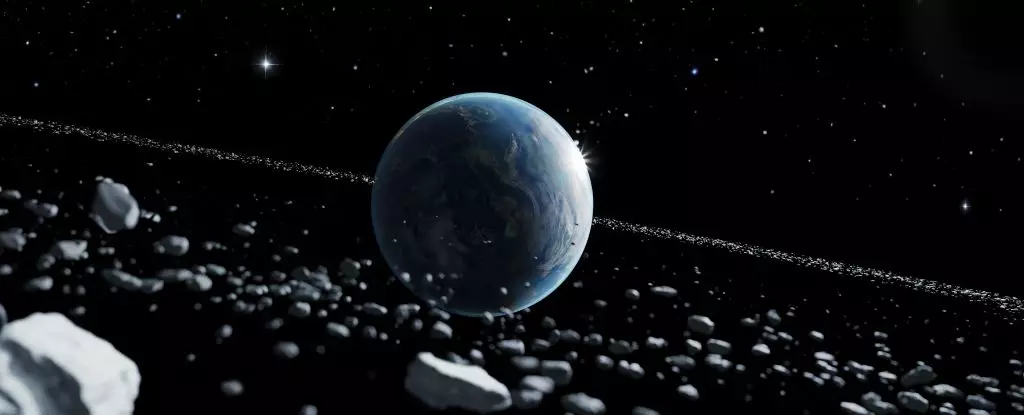For far too long, discussions about Earth’s history have centered on its fundamental geological transformations and the evolution of life itself. One particularly intriguing aspect often overlooked is the possibility that Earth may have once possessed a spectacular feature – a planetary ring. This would have dramatically altered not only the view from the surface but also left a lasting mark on the planet’s geological record. Recent analyses, spearheaded by planetary scientist Andy Tomkins from Monash University, propose that a ring might have existed during the Ordovician period approximately 466 million years ago, leading to a spike in meteorite impacts. These findings provoke exciting questions about the nature of our planet and its past.
The Ordovician period witnessed a curious spike in meteorite impacts, a phenomenon dubbed the Ordovician Impact Spike. This era, characterized by a series of environmental transformations, also signaled a dramatic increase in meteorite activity on Earth’s surface. Tomkins and his team have delved into the geological record, examining sediment layers rich in meteorite debris coinciding with this period of heightened impacts. Their hypothesis suggests that debris from an ancient ring orbiting Earth contributed to this anomaly. Notably, the craters resulting from these impacts exhibit a peculiar clustering pattern, concentrated primarily within a narrow strip around the equator—a striking arrangement that beckons further scrutiny.
According to Tomkins, the evidence points to the breakup of an asteroid as the catalyst for the formation of the hypothesized ring. When this celestial body approached Earth, it would have encountered our planet’s gravitational forces, becoming subject to what is known as the Roche limit. At this critical threshold, the asteroid would have been torn apart, unleashing its remnants into orbit around Earth. This scenario not only explains the proximity of the meteorite impacts but also hints at the short-lived nature of such an ancient ring; while it may have adorned our planet for tens of millions of years, it eventually decayed into the atmosphere. This process resonates with observations of ring systems around other planets—Saturn, for example, provides a vivid comparison, showcasing how various forces can influence a ring’s dynamics.
Beyond mere nostalgia for a more embellished Earth, the implications of this research extend into the realms of climate and evolution. Tomkins speculates that the hypothesized ring may have had far-reaching effects on climatic conditions during the Ordovician. The possibility that such a ring could cast shadows across the surface raises intriguing questions about its contributions to Earth’s cooling trends during this period. This cooling could have intertwined with the Great Ordovician Biodiversification Event, positing that a shifting climate may have spurred rapid evolution among organisms struggling to adapt.
The crossroads of climate changes and evolutionary pressures suggest a complex interplay that shaped the diversity of life on Earth. If verified, this theory paints the ring as a pivotal player in transforming Earth’s evolutionary trajectory.
Though the evidence for Earth’s ring exists primarily within the realms of speculation, Tomkins emphasizes the importance of numerical modeling to deepen our understanding. With advanced simulations, researchers can recreate the asteroid’s disintegration and the subsequent development of a ring, examining its characteristics and the nature of its cosmic dance around our planet. This modeling is a crucial next step in unveiling not only the ring’s possible structure but also understanding the ecological and climatic ramifications it might have wrought.
The discussions surrounding such modeling are not merely academic exercises but could offer insights into climate interventions. The potential for geoengineering strategies inspired by ancient celestial events provides a provocative lens through which to consider modern challenges—could we, for instance, terraform a planet like Venus by introducing an orbiting mass of cooling debris?
While the hypothesis of an ancient Earth ring remains speculative for now, it serves as a catalyst for broader inquiries into our planet’s history. The potential discovery of a ring reaffirms the romantic notion that Earth has gone through extraordinary changes, leaving profound influences on our environment and life. The idea thrives on imagination and scientific curiosity, underscoring the interconnectedness of cosmic events and terrestrial life. As we tread further into the realms of planetary science and modeling, one must wonder—what further secrets of Earth’s past await discovery, and how do they challenge our perspective of the present and the future?


Leave a Reply